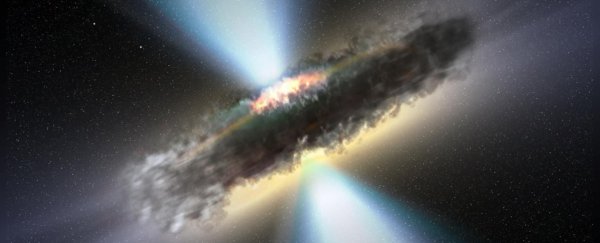A long time ago, in a galaxy far, far away, there was one hell of a bang. The event represents the most energetic example of a class of explosions that currently lack a clear explanation.
Astronomers have narrowed the likely cause down to two contenders, but so far they don't know which is correct. When they figure it out, it will mean a completely new type of cosmic eruption that could help us better understand what's going on in the extreme depths of galactic cores.
An international team of astronomers discovered the transient brightening of a star back in 2010 using the Panoramic Survey Telescope and Rapid Response System (Pan-STARRS) at Haleakala Observatory, Hawaii.
Dubbed PS1-10adi, the object sits in the centre of a galaxy roughly 2.6 billion light years away. Taking into account the expansion of the Universe, that means it took just under 2.5 billion years for its light to get here.
Over the course of several years, the PS1-10adi's light changed, glowing brilliantly until it slowly blended into the background radiance of its host galaxy.
On the face of it, it seems as if the event was just another dying star giving up one last hurrah. In fact, the signature embedded in its spectra spelled Type IIn supernova.
But its luminosity was remarkably bright, even for a particularly energetic exploding star, prompting researchers to wonder if it could be caused by something else.
"The discovery we made has revealed explosions capable of releasing an amount of energy ten times bigger than normal explosions," says astronomer Cosimo Inserra from the University of Southampton.
One contender is an active galactic nuclei (AGN). These monsters are bright patches of light that emerge and fade in the centre of galaxies as a result of all kinds of cosmic phenomena - for example, the hot particles and radiation expelled from black holes.
Astronomers divide AGNs into smaller groups based on their own light signatures. One such group, called a type 1 Seyfert galaxy, also lines up neatly with this particular explosion.
Given the amount of energy involved, this is either a particularly impressive supernova of a star at least a few hundred times more massive than our Sun, or a smaller object being dramatically ripped to shreds by a big black hole.
Either of the scenarios could explain PS1-10adi, and both are super-exciting options for astronomers.
"If these explosions are tidal disruption events – where a star gets sufficiently close to a supermassive black hole's event horizon and is shredded by the strong gravitational forces – then its properties are such that it would be a brand new type of tidal disruption event," says the study's lead author Erkki Kankare, an astrophysicist from Queen's University Belfast.
"If they are supernova explosions then their properties are more extreme than we have ever observed before, and are likely connected to the central environments of the host galaxies."
Having squeezed what they could from PS1-10adi's data, the team went back to the survey and other databases to see if they could find examples of explosions with similar characteristics among other transient events.
They found a bunch, four of which they then detailed for in their study.
"Our data show that events like this are not very unusual and challenge our knowledge of exploding and disrupting stars," says Inserra.
"At the same time, their existence provides us with important information about the extreme environment in the central, hidden, part of galaxies."
New technologies are on the horizon that will provide more detail than ever on the centres of distant galaxies. Hopefully we won't need to wait too long to have this mystery solved.
This research was published in Nature Astronomy.
